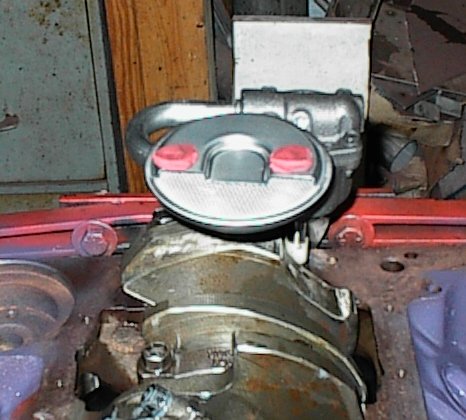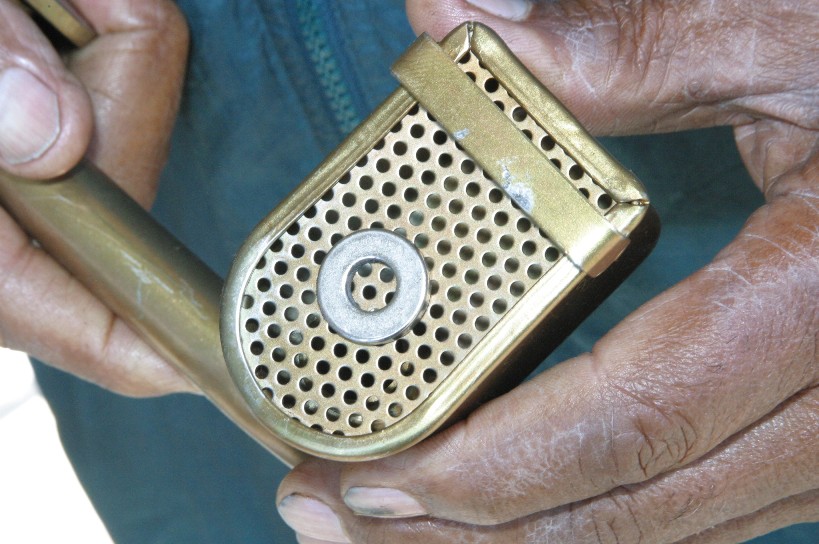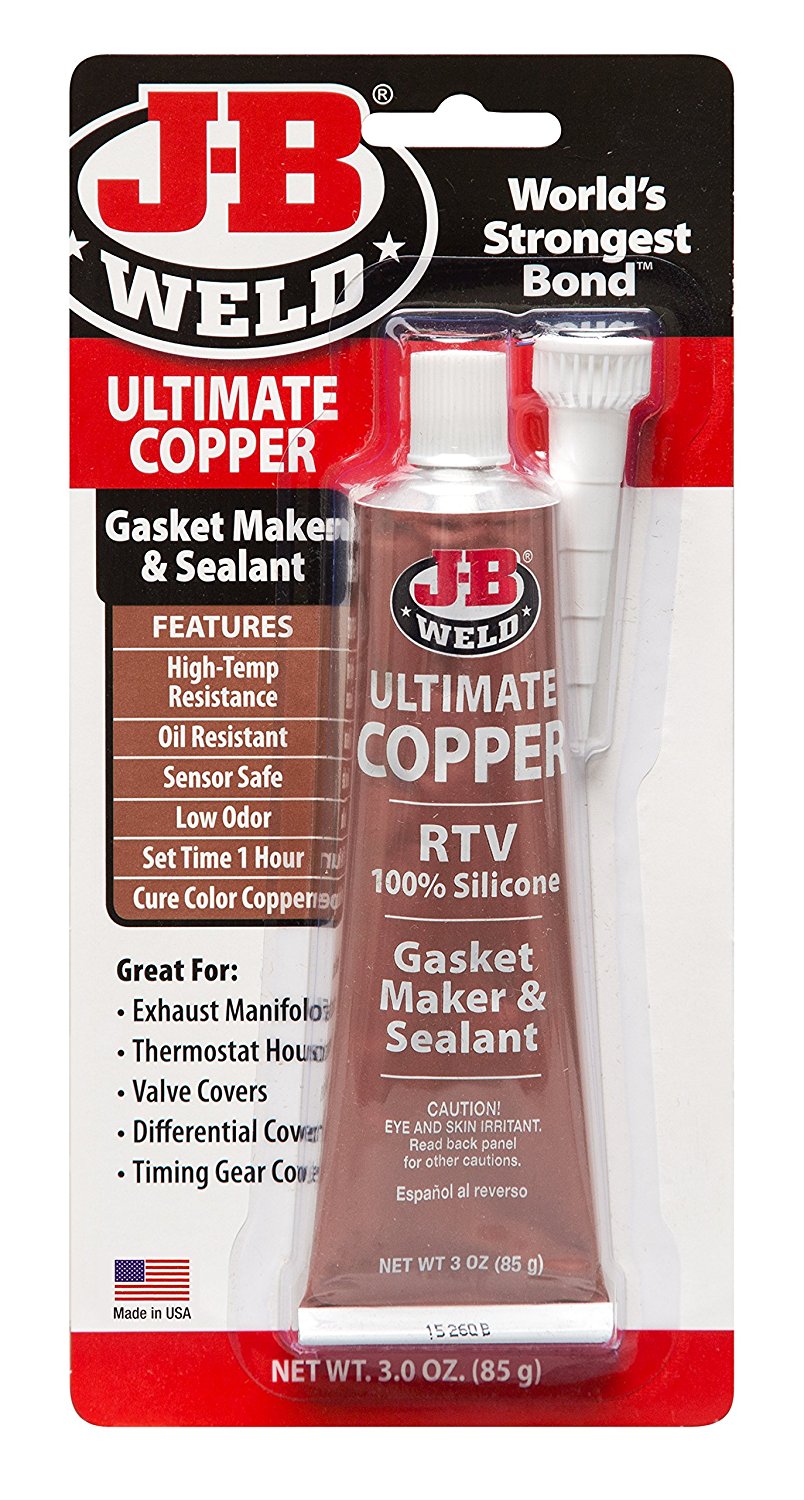the gasket is about .125 thick so that in theory should provide the oil pump pick-up with a minimum 1/4" pick-up to oil pan clearance which will need to be verified with some clay and a test fitting. you really want 3/8" under the oil pump pick-up lower surface to the oil pan floor.
before you get crazy you'll want to do the test and verify what your dealing with
if and when you need more clearance between the two you can either swap oil pump pick-ups or modify the current components and in most cases a few whacks with a rubber mallet on the pick-up assembly held in a vise , some careful test fitting and brazing the pick-up into place once your sure the clearance is correct, should provide the required clearance
more than one guys added a powerful magnet on the pick-up to pull metallic crap out of the oil
http://www.kjmagnetics.com/proddetail.asp?prod=D61SH
read these
youll occasionally find uses for a high temp rated silicone sealant
like ultra-copper that has about twice the temp tolerance of the common black RTV
What you need to know when you’re working on today’s engines
Next Generation Gasket Makers:
If you’ve ever replaced a water pump, dropped an oil pan, or bolted on an intake manifold, you may have used a gasket maker instead of running out to the parts store for a gasket.
Gasket makers can save you time and money, and they provide excellent sealing capabilities. But the gasket maker that was developed 20 years ago may not be best for the engine you’re working on today. Here’s why.
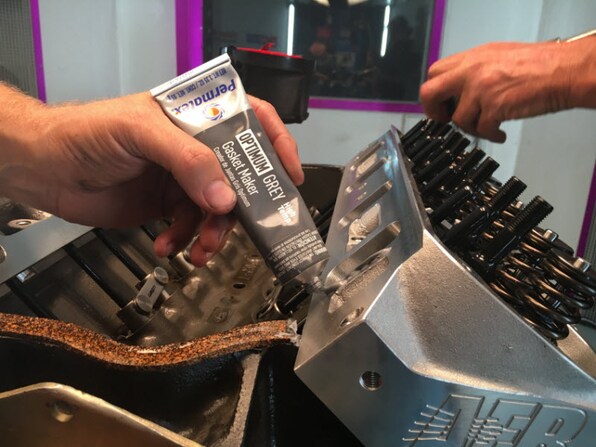 Engines have evolved. So have the demands on gasket makers.
Engines have evolved. So have the demands on gasket makers.
Engineers have been using gaskets to seal connections between mechanical assemblies since the days of the steam engine. Gaskets were originally made of organic materials like compressed paper, cork, and rubber. But as engine technology evolved, so did gasket materials. Using RTV silicones to replace ‘cut gaskets’ became popular in the 1980s. They provided a tight, flexible, and durable seal. And if you kept them on hand, they eliminated the need to run to the auto parts store for a gasket. But since the 1980s, engine technology has continued to evolve, putting new demands on gasket makers.
To be effective in today’s engines, a gasket maker needs to:
Hold up under extreme high vibration
Modern engines work to get more power out of less displacement. Instead of the old, smooth-running, low rev V8, you get the high-frequency vibration of a free-revving 4 or 6-cylinder engine. Even V8s are running with higher vibration as carmakers and performance junkies take the horsepower arms race to new heights. The 1997 Corvette C5 Z06 put out 385 HP, and was considered a beast at the time. Today, the base model 2018 Corvette puts out 455 HP while the ZR1 delivers 638 HP. That means more stress on components and the gasket makers holding them together.
Resist higher torque loads
Just as the horsepower produced by modern engines continues to climb, so does torque. The higher twisting forces in today’s more powerful engines put an additional demand on gasket makers (and gaskets for that matter).
Hold up to higher heat
Along with all the extra power comes more heat. A classic muscle car had enough air space around the engine to fit a couple of pit bulls. All that air space helped keep things cooler. Modern engine compartments are packed tighter than a frequent flyer’s roll-on luggage. Plus, vehicle manufacturers are upping the coolant temperatures to help meet emissions standards. At one time, 160°F was a common temperature for fully warmed up coolant. Coolant in today’s higher efficiency engines typically runs at over 200°F. So, when the power comes on, that engine compartment becomes a real oven, creating another new level of stress on gaskets and gasket makers.
Stand up to modern oils and shop fluids
Gaskets and gasket makers have always had to stand up to oil and other shop fluids found under the hood. But today’s long-life oils and high-tech engine fluids use advanced additive packages to boost their service life and performance. Those additives are more aggressive towards gasket makers (and gaskets), presenting yet another challenge for traditional gasket makers.
Deliver higher flexibility
Once upon a time, the engine block and most of the components bolted onto it were iron, and they all flexed with each other nicely as temperatures and revs changed. Today’s engines mix components of radically different metallurgy, and each assembly will have it’s own rate of flex under load. In addition, performance fans are bolting on premium components that have their own unique flex behaviors. The result? To be effective in today’s applications, a gasket maker needs to be a lot more flexible, while still retaining full sealing strength.
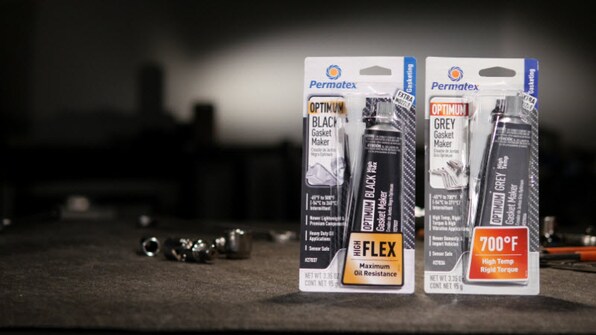 Answering the challenge
Answering the challenge
The engineers at Permatex saw these factors developing over time and recognized the need to provide a higher level of gasket maker performance. Drawing on decades of experience in advancing sealing technology, they developed Permatex OPTIMUM Gasket Makers. Designed to deliver superior sealing capability in today’s most demanding applications, Permatex OPTIMUM GREY Gasket Maker and OPTIMUM BLACK Gasket Makers are now available to meet the challenges presented by modern engine technologies.
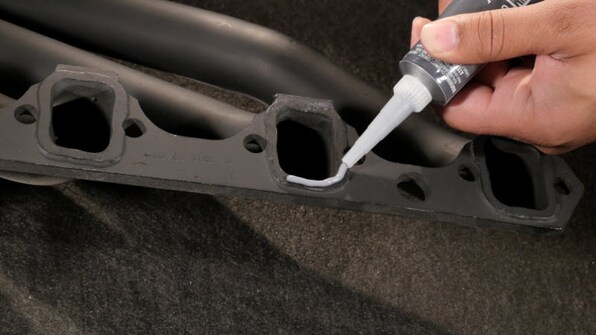 Permatex OPTIMUM GREY
Permatex OPTIMUM GREY
Specially formulated to withstand high vibration and high temperatures up to 700°F, Permatex OPTIMUM GREY Gasket Maker is a premium choice for high temperature applications and rigid joints that experience high torque loads. It was engineered for heavy-duty applications and extreme temperature conditions from -65°F to 700°F, and is ideal for newer domestic and import vehicles.
OPTIMUM GREY offers maximum vibration resistance and is 15% more flexible and has a 40% higher temperature rating than Permatex Ultra GREY. OPTIMUM GREY Gasket Maker is sensor safe, low odor, and non-corrosive.
Offering maximum vibration resistance, OPTIMUM GREY is the most advanced, high temp, maximum torque RTV silicone gasket maker available.
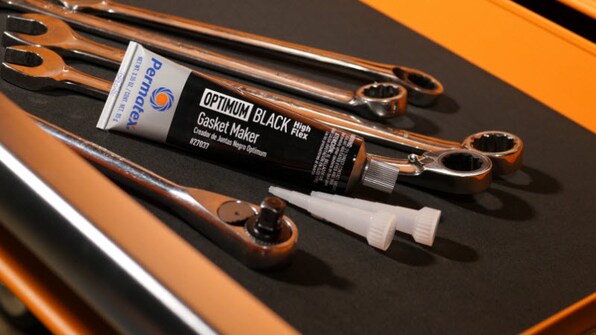 Permatex OPTIMUM BLACK
Permatex OPTIMUM BLACK
Specially formulated for high flexibility and maximum oil resistance, Permatex OPTIMUM BLACK Gasket Maker retains the high flexibility and maximum resistance to oil and shop fluids. It’s the optimal choice for today’s lightweight and premium components, especially where two dissimilar metals meet. OPTIMUM BLACK offers a temperature range of -65°F to 500°F and is 15% stronger and 60% more flexible than Permatex Ultra BLACK.
OPTIMUM BLACK is sensor-safe, low odor, and non-corrosive. It is resistant to auto and shop fluids and vibration. It’s one of the most advanced, high flex, maximum oil resistant RTV silicone gasket makers available.
Applications for OPTIMUM BLACK include valve covers, oil pans, oil pumps, intake manifold end seals, and timing covers.
To make OPTIMUM Gasket Makers user friendly, an extra nozzle is included to avoid nozzle clogs and deliver maximum use.
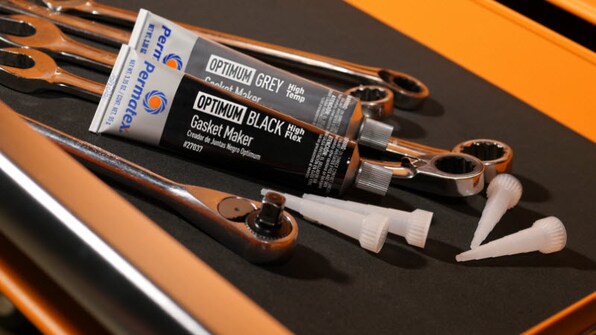 Why a gasket maker instead of a gasket?
Why a gasket maker instead of a gasket?
As we noted, using a gasket maker instead of a conventional gasket can save a whole lot of time and money, and those are two reasons why pros use Permatex gasket makers and flange sealants.
Automakers use gasket makers when they build their vehicles and when a vehicle needs service, gasket makers can be used to match what was used at the factory. But most of the time, you’ll see them being used to replace a traditional gasket. Today’s gasket makers have tremendous reliability. They can eliminate leak paths that traditional gaskets can’t. And, they’re super-resistant to vibration, fluids, and temperature cycles. Plus, using a gasket maker ensures that you’ll never run into the trouble of an auto parts store not having the exact formed gasket that you need.
The full line of Permatex Gasket Makers
In addition to the new line of OPTIMUM Gasket Makers, Permatex has traditional RTV gasket makers that are specially formulated for sensor-safe applications, automatic transmissions, water pumps, and thermostats, as well as for applications that come in contact with gear oil. Permatex also offers Permatex The Right Stuff Gasket Maker. This 1-Minute Gasket Maker was specially designed for professional technicians, so that they could simply apply the gasket maker, torque, and go. Permatex The Right Stuff seals instantly, so your repair can get back into service immediately.
For more information, check out
www.permatex.com. You’ll find product specs, technical data sheets, and instructional videos to help you learn more about which Permatex Gasket Maker is right for your job.
viewtopic.php?f=54&t=65
viewtopic.php?f=54&t=1800
viewtopic.php?f=54&t=206
viewtopic.php?f=54&t=1192
viewtopic.php?f=51&t=1718&p=4257&hilit=+rear+seal#p4257
viewtopic.php?f=51&t=1458&p=3265&hilit=shrapnel#p3265
viewtopic.php?f=54&t=2187&p=11571&hilit=windage+tray#p11571
viewtopic.php?f=54&t=64&p=1733&hilit=+windage+tray#p1733
viewtopic.php?f=54&t=4480



